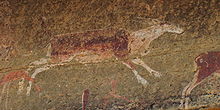Maloti Drakensberg Park
| Maloti Drakensberg Park | |
|---|---|
|
UNESCO world heritage |
|

|
|
| National territory: |
|
| Type: | Culture / nature |
| Criteria : | (i) (iii) (vii) (x) |
| Surface: | 249,313 ha |
| Buffer zone: | 46,630 ha |
| Reference No .: | 985bis |
| UNESCO region : | Africa |
| History of enrollment | |
| Enrollment: | 2000 (session 24) |
| Extension: | 2013 |
The Maloti-Drakensberg Park is a transboundary UNESCO - World Heritage Site , which results from the uKhahlamba-Drakensberg Park in South Africa and the Sehlabathebe National Park in Lesotho composed. The park is known for its spectacular natural landscape, its importance as a haven for many endangered and endemic species, and for its wealth of rock art , created by the San people over a period of 4000 years.
description
The World Heritage Maloti Drakensberg Park is a transnational protected area that stretches across the border between the Kingdom of Lesotho and the Republic of South Africa . The area includes the Sehlabathebe National Park (6500 ha) in Lesotho and the uKhahlamba Drakensberg Park (242,813 ha) in South Africa. The site covers a total area of 249,313 ha, making it the largest complex of protected areas along the Great Peripheral Step in southern Africa.
The Maloti Drakensberg Park mountain range is the most important water supply area in southern Africa. The border between the two countries forms the watershed for two of the largest catchment areas in southern Africa. The Thukela River from the Ukhahlamba Drakensberg Park flows east into the Indian Ocean . The rivers of the southern Maloti-Drakensberg including the Sehlabathebe National Park drain into the Senqu / Oranje , which flows westward into the Atlantic Ocean .
With its pristine, steeply sloping river valleys and rocky gorges, the site has numerous caves and rock shelters with an estimated 690 rock art sites and over 35,000 individual images. The pictures show animals and people and give insights into the spiritual life of the San people. They testify to an exceptionally coherent tradition that has embodied their beliefs and worldview for several millennia . There are also rock paintings from the 19th and 20th centuries that are ascribed to the Bantu- speaking peoples.
The world heritage site offers more than 250 endemic plant species and the fauna associated with them a vital retreat . The uKhahlamba Drakensberg Park is also home to almost all of the remaining subalpine and alpine vegetation of the KwaZulu-Natal Province , including extensive wetlands at altitudes above 2,750 m and is a Ramsar area . It has been designated as an Important Bird Area and forms an important part of the Lesotho Highlands Endemic Bird Area .
Registration as world heritage
In 2000, the Ukhahlamba-Drakensberg Park was first entered on the UNESCO World Heritage List as a mixed World Heritage Site in South Africa, based on a resolution of the 24th session of the World Heritage Committee. In 2013 the Sehlabathebe National Park from Lesotho was added and the name was changed to Maloti-Drakensberg-Park .
The World Heritage Site covers an area of 249,313 hectares with a buffer zone of 46,630 hectares.
The entry was made on the basis of criteria (i), (iii), (vii) and (x).
(i): The rock art of the Maloti Drakensberg Park is the largest and densest group of rock art in sub-Saharan Africa and is characterized by both its quality and its thematic diversity.
(iii): The San people lived in the mountainous area of the Maloti Drakensberg for more than four millennia and left behind a work of outstanding rock art, a unique testimony that sheds light on their way of life and their beliefs.
(vii): The site has an exceptional natural beauty with towering basaltic rocks, succinct, spectacular backdrops and golden sandstone walls. Hilly, high-lying grasslands, pristine, steeply sloping river valleys, and rocky gorges also add to the beauty of the site.
(x): The area contains significant natural habitats for the conservation of local biodiversity. It has an outstanding biodiversity, especially plants. It is recognized as a global center for plant diversity and endemism and belongs to its own flora region - the "Drakensberg Alpine Region of South Africa". It is also located in a globally important endemic bird area and is notable for the occurrence of a number of globally threatened species, such as the yellow-breasted pipit . The diversity of habitats is outstanding and extends over alpine plateaus, steep rocky slopes and river valleys. These habitats protect endemic and threatened species to a high degree.
See also
Web links
- Entry on the UNESCO World Heritage Center website ( English and French ).
- World Database on Protected Areas - Maloti-Drakensberg-Park (English)
Individual evidence
- ↑ a b c d e f g Entry on the website of the UNESCO World Heritage Center ( English and French ).
- ↑ Decision: CONF 204 XB1 - uKhahlamba / Drakensberg Park (South Africa). UNESCO World Heritage Center, 2000, accessed August 5, 2020 .
- ↑ Decision: 37 COM 8B.18 - Maloti-Drakensberg Park (Lesotho / South Africa). UNESCO World Heritage Center, 2013, accessed August 5, 2020 .
Coordinates: 29 ° 24 ' S , 29 ° 33' E

